light YAMAHA TDM 900 2003 Owners Manual
[x] Cancel search | Manufacturer: YAMAHA, Model Year: 2003, Model line: TDM 900, Model: YAMAHA TDM 900 2003Pages: 110, PDF Size: 7.38 MB
Page 14 of 110

INSTRUMENT AND CONTROL FUNCTIONS
Main switch/steering lock ...................................................................3-1
Indicator and warning lights ...............................................................3-2
Speedometer unit ..............................................................................3-4
Tachometer unit .................................................................................3-5
Coolant temperature gauge ...............................................................3-6
Anti-theft alarm (optional) ..................................................................3-7
Handlebar switches ...........................................................................3-7
Clutch lever ........................................................................................3-9
Shift pedal ..........................................................................................3-9
Brake lever ........................................................................................3-9
Brake pedal .....................................................................................3-10
Fuel tank cap ...................................................................................3-10
Fuel ..................................................................................................3-11
Fuel tank breather hose ...................................................................3-12
Catalytic converter ...........................................................................3-12
Seat .................................................................................................3-13
Storage compartment ......................................................................3-14
Adjusting the front fork .....................................................................3-14
Adjusting the shock absorber assembly ..........................................3-16
Luggage strap holders .....................................................................3-18
Sidestand .........................................................................................3-18
Ignition circuit cut-off system ...........................................................3-19
3
5PS-28199-E1 8/29/02 9:16 AM Page 13
Page 15 of 110
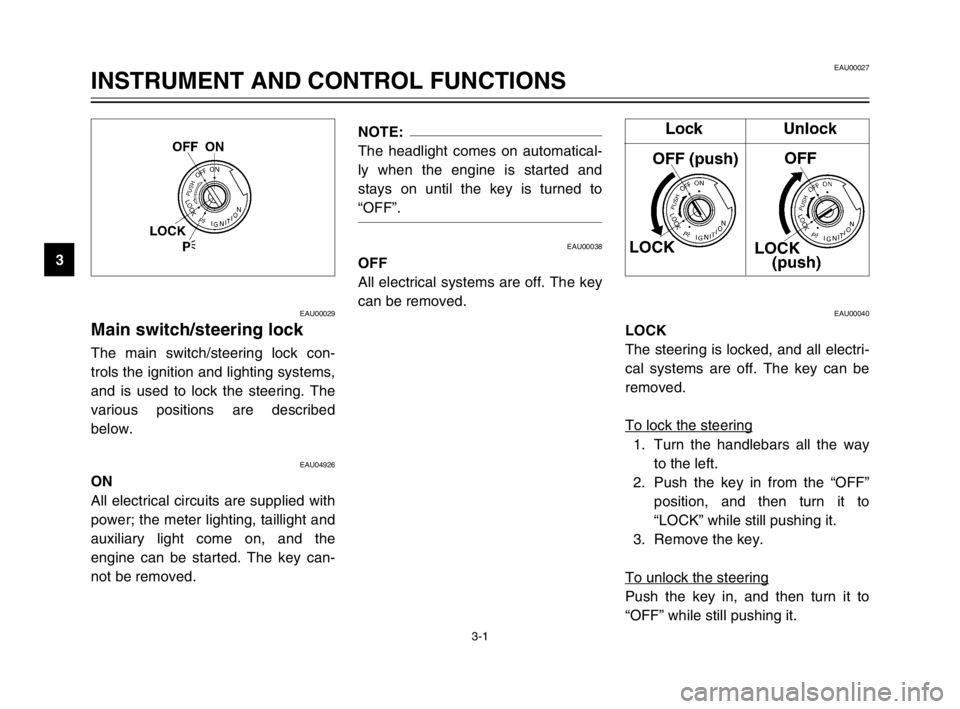
3-1
EAU00029
Main switch/steering lockMain switch/steering lockThe main switch/steering lock con-
trols the ignition and lighting systems,
and is used to lock the steering. The
various positions are described
below.
EAU04926
ON
All electrical circuits are supplied with
power; the meter lighting, taillight and
auxiliary light come on, and the
engine can be started. The key can-
not be removed.
EAU00027
INSTRUMENT AND CONTROL FUNCTIONS
3
NOTE:
The headlight comes on automatical-
ly when the engine is started and
stays on until the key is turned to
“OFF”.
EAU00038
OFF
All electrical systems are off. The key
can be removed.
EAU00040
LOCK
The steering is locked, and all electri-
cal systems are off. The key can be
removed.
To lock the steering
1. Turn the handlebars all the way
to the left.
2. Push the key in from the “OFF”
position, and then turn it to
“LOCK” while still pushing it.
3. Remove the key.
To unlock the steering
Push the key in, and then turn it to
“OFF” while still pushing it.
5PS-28199-E1 8/29/02 9:16 AM Page 14
Page 16 of 110
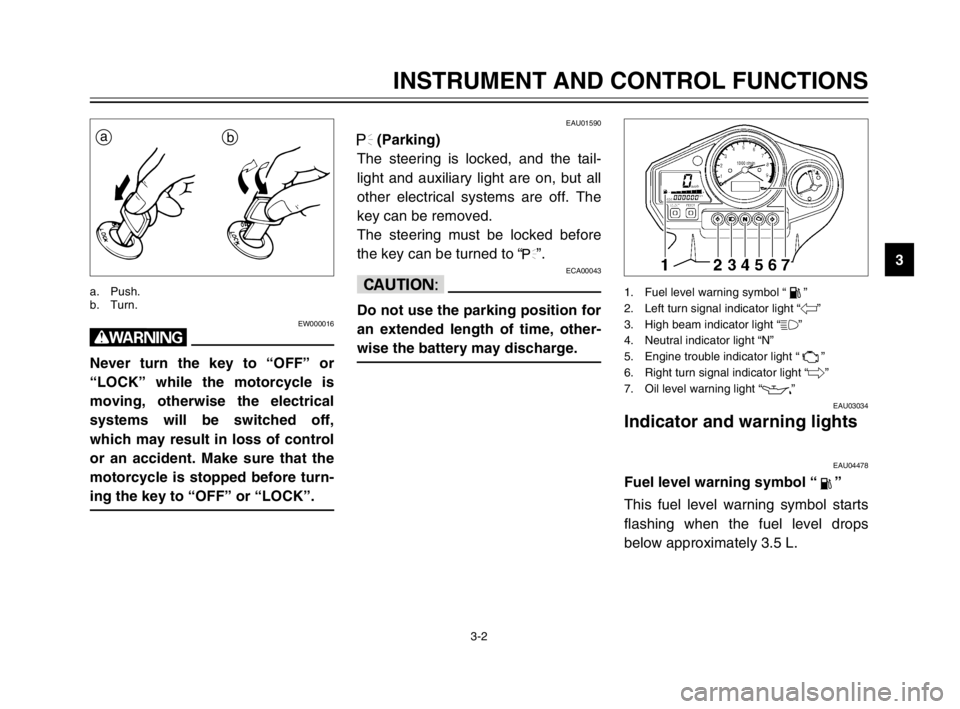
3-2
INSTRUMENT AND CONTROL FUNCTIONS
3
EW000016
w
Never turn the key to “OFF” or
“LOCK” while the motorcycle is
moving, otherwise the electrical
systems will be switched off,
which may result in loss of control
or an accident. Make sure that the
motorcycle is stopped before turn-
ing the key to “OFF” or “LOCK”.
ab
a. Push.
b. Turn.
EAU03034
Indicator and warning lights
Indicator and warning lightsEAU04478
Fuel level warning symbol “”Fuel level warning symbolThis fuel level warning symbol starts
flashing when the fuel level drops
below approximately 3.5 L.
1. Fuel level warning symbol “ ”
2. Left turn signal indicator light “
4”
3. High beam indicator light “&”
4. Neutral indicator light “N”
5. Engine trouble indicator light “ ”
6. Right turn signal indicator light “6”
7. Oil level warning light “
7”
EAU01590
.(Parking)
The steering is locked, and the tail-
light and auxiliary light are on, but all
other electrical systems are off. The
key can be removed.
The steering must be locked before
the key can be turned to “
.”.ECA00043
cC
Do not use the parking position for
an extended length of time, other-
wise the battery may discharge.
5PS-28199-E1 8/29/02 9:16 AM Page 15
Page 17 of 110
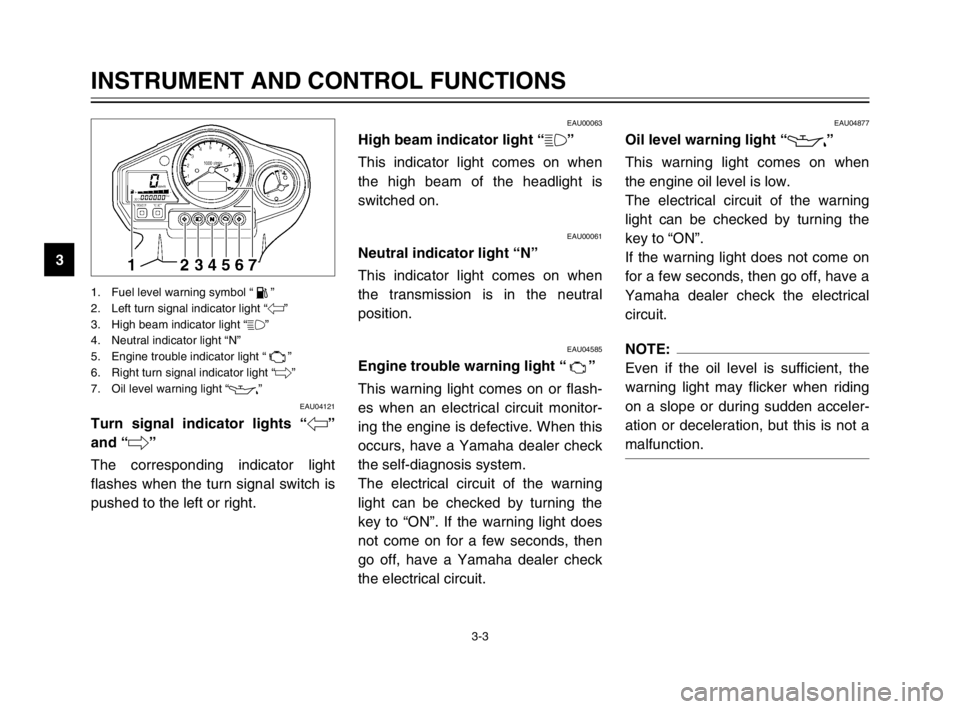
3-3
INSTRUMENT AND CONTROL FUNCTIONS
3
EAU04877
Oil level warning light “7”Oil level warning lightThis warning light comes on when
the engine oil level is low.
The electrical circuit of the warning
light can be checked by turning the
key to “ON”.
If the warning light does not come on
for a few seconds, then go off, have a
Yamaha dealer check the electrical
circuit.
NOTE:
Even if the oil level is sufficient, the
warning light may flicker when riding
on a slope or during sudden acceler-
ation or deceleration, but this is not a
malfunction.
1. Fuel level warning symbol “ ”
2. Left turn signal indicator light “4”
3. High beam indicator light “&”
4. Neutral indicator light “N”
5. Engine trouble indicator light “ ”
6. Right turn signal indicator light “6”
7. Oil level warning light “
7”
EAU04121
Turn signal indicator lights “4”
and “6”
Turn signal indicator lightsThe corresponding indicator light
flashes when the turn signal switch is
pushed to the left or right.
EAU00063
High beam indicator light “&”High beam indicator lightThis indicator light comes on when
the high beam of the headlight is
switched on.
EAU00061
Neutral indicator light “N”Neutral indicator lightThis indicator light comes on when
the transmission is in the neutral
position.
EAU04585
Engine trouble warning light “”Engine trouble warning lightThis warning light comes on or flash-
es when an electrical circuit monitor-
ing the engine is defective. When this
occurs, have a Yamaha dealer check
the self-diagnosis system.
The electrical circuit of the warning
light can be checked by turning the
key to “ON”. If the warning light does
not come on for a few seconds, then
go off, have a Yamaha dealer check
the electrical circuit.
5PS-28199-E1 8/29/02 9:16 AM Page 16
Page 21 of 110
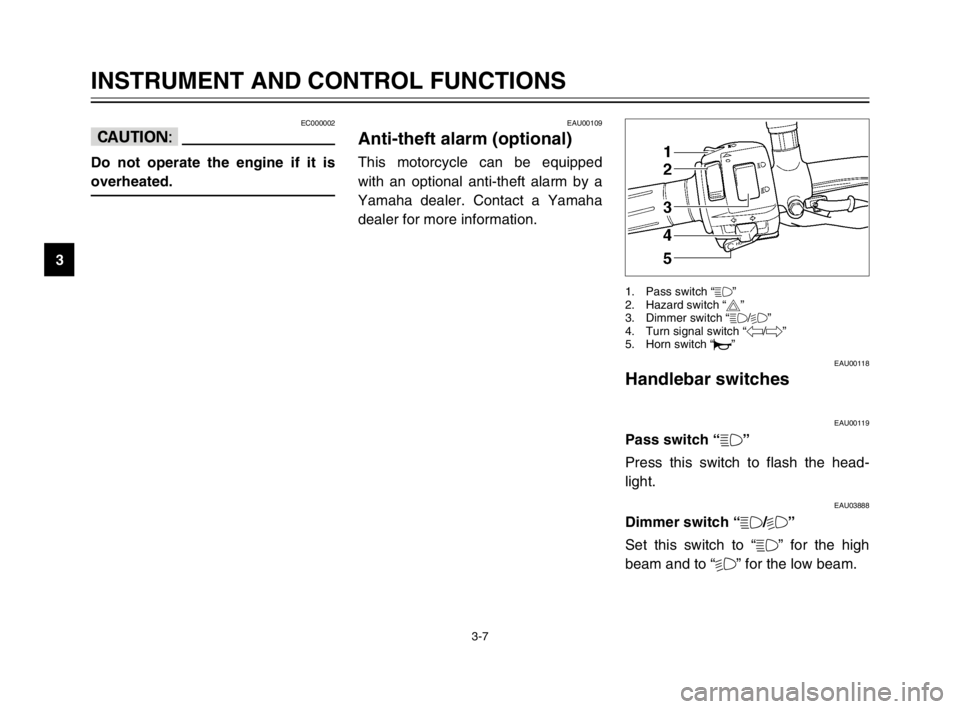
3-7
INSTRUMENT AND CONTROL FUNCTIONS
3
EC000002
cC
Do not operate the engine if it is
overheated.
EAU00118
Handlebar switches
Handlebar switchesEAU00119
Pass switch “&”Pass switchPress this switch to flash the head-
light.
EAU03888
Dimmer switch “&/%”Dimmer switchSet this switch to “&” for the high
beam and to “%” for the low beam.
1. Pass switch “&”
2. Hazard switch “0”
3. Dimmer switch “&/%”
4. Turn signal switch “4/6”
5. Horn switch “*”
EAU00109
Anti-theft alarm (optional)Anti-theft alarm (optional)This motorcycle can be equipped
with an optional anti-theft alarm by a
Yamaha dealer. Contact a Yamaha
dealer for more information.
5PS-28199-E1 8/29/02 9:16 AM Page 20
Page 22 of 110
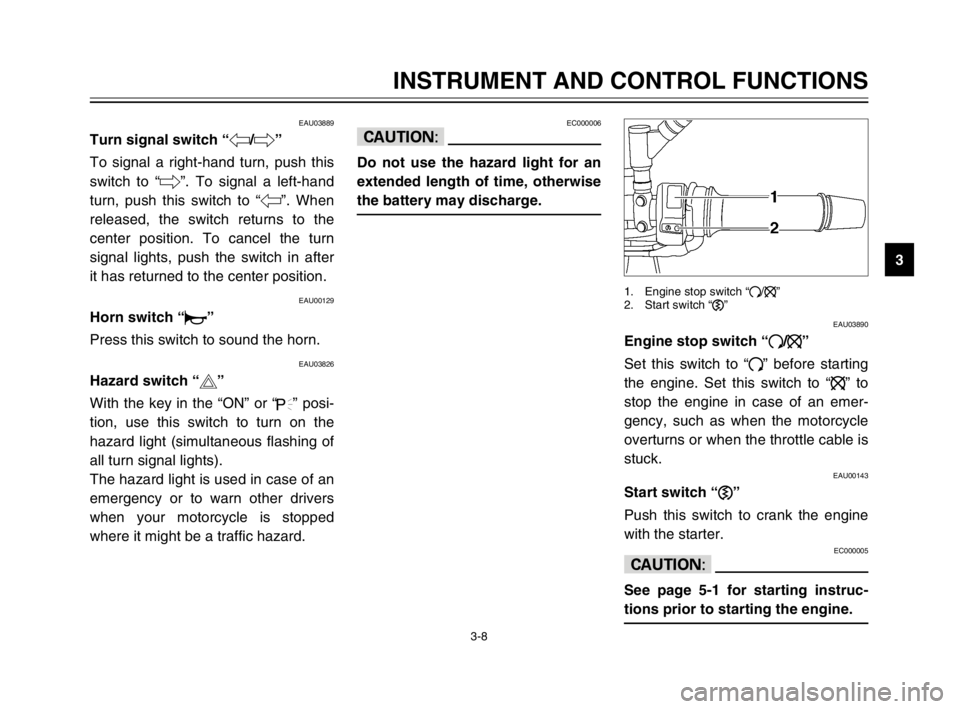
3-8
INSTRUMENT AND CONTROL FUNCTIONS
3
EAU03889
Turn signal switch “4/6”Turn signal switchTo signal a right-hand turn, push this
switch to “6”. To signal a left-hand
turn, push this switch to “4”. When
released, the switch returns to the
center position. To cancel the turn
signal lights, push the switch in after
it has returned to the center position.
EAU00129
Horn switch “*”Horn switchPress this switch to sound the horn.
EAU03826
Hazard switch “0”Hazard switchWith the key in the “ON” or “.” posi-
tion, use this switch to turn on the
hazard light (simultaneous flashing of
all turn signal lights).
The hazard light is used in case of an
emergency or to warn other drivers
when your motorcycle is stopped
where it might be a traffic hazard.
EC000006
cC
Do not use the hazard light for an
extended length of time, otherwise
the battery may discharge.
EAU03890
Engine stop switch “#/$”Engine stop switchSet this switch to “#” before starting
the engine. Set this switch to “$” to
stop the engine in case of an emer-
gency, such as when the motorcycle
overturns or when the throttle cable is
stuck.
EAU00143
Start switch “,”Start switchPush this switch to crank the engine
with the starter.
EC000005
cC
See page 5-1 for starting instruc-
tions prior to starting the engine.
1. Engine stop switch “#/$”
2. Start switch “,”
5PS-28199-E1 8/29/02 9:16 AM Page 21
Page 38 of 110

4-2
PRE-OPERATION CHECKS
4
Throttle grip•Make sure that operation is smooth.
•Check cable free play.
•If necessary, have Yamaha dealer adjust cable free play and lubricate cable and
grip housing.6-18, 6-29
Control cables•Make sure that operation is smooth.
•Lubricate if necessary.6-29
Drive chain•Check chain slack.
•Adjust if necessary.
•Check chain condition.
•Lubricate if necessary.6-27–6-29
Wheels and tires•Check for damage.
•Check tire condition and tread depth.
•Check air pressure.
•Correct if necessary.6-18–6-22
Brake and shift pedals•Make sure that operation is smooth.
•Lubricate pedal pivoting points if necessary.6-30
Brake and clutch levers•Make sure that operation is smooth.
•Lubricate lever pivoting points if necessary.6-30
Sidestand•Make sure that operation is smooth.
•Lubricate pivot if necessary.6-30
Chassis fasteners•Make sure that all nuts, bolts and screws are properly tightened.
•Tighten if necessary.—
Instruments, lights, signals
and switches•Check operation.
•Correct if necessary.3-2–3-3, 3-7–3-8, 6-35–6-38
Sidestand switch•Check operation of ignition circuit cut-off system.
•If system is defective, have Yamaha dealer check vehicle.3-18–3-20 ITEM CHECKS PAGE
5PS-28199-E1 8/29/02 9:16 AM Page 37
Page 41 of 110
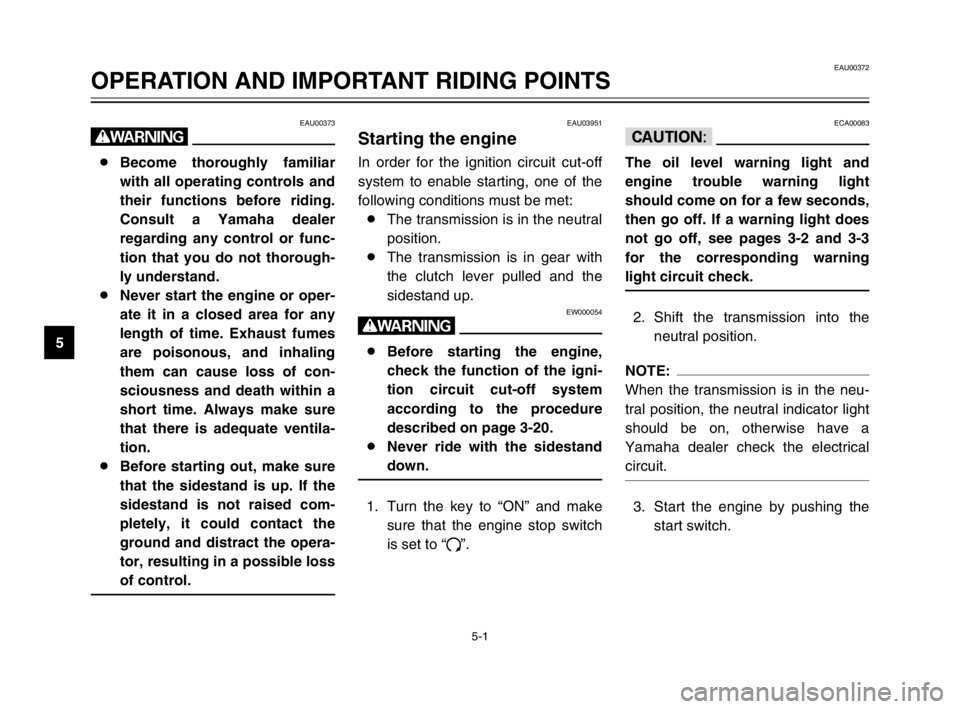
5-1
EAU00372
OPERATION AND IMPORTANT RIDING POINTS
5
EAU00373
w
8Become thoroughly familiar
with all operating controls and
their functions before riding.
Consult a Yamaha dealer
regarding any control or func-
tion that you do not thorough-
ly understand.
8Never start the engine or oper-
ate it in a closed area for any
length of time. Exhaust fumes
are poisonous, and inhaling
them can cause loss of con-
sciousness and death within a
short time. Always make sure
that there is adequate ventila-
tion.
8Before starting out, make sure
that the sidestand is up. If the
sidestand is not raised com-
pletely, it could contact the
ground and distract the opera-
tor, resulting in a possible loss
of control.
EAU03951
Starting the engineStarting the engineIn order for the ignition circuit cut-off
system to enable starting, one of the
following conditions must be met:
8The transmission is in the neutral
position.
8The transmission is in gear with
the clutch lever pulled and the
sidestand up.
EW000054
w
8Before starting the engine,
check the function of the igni-
tion circuit cut-off system
according to the procedure
described on page 3-20.
8Never ride with the sidestand
down.
1. Turn the key to “ON” and make
sure that the engine stop switch
is set to “#”.
ECA00083
cC
The oil level warning light and
engine trouble warning light
should come on for a few seconds,
then go off. If a warning light does
not go off, see pages 3-2 and 3-3
for the corresponding warning
light circuit check.
2. Shift the transmission into the
neutral position.
NOTE:
When the transmission is in the neu-
tral position, the neutral indicator light
should be on, otherwise have a
Yamaha dealer check the electrical
circuit.
3. Start the engine by pushing the
start switch.
5PS-28199-E1 8/29/02 9:16 AM Page 40
Page 42 of 110

5-2
OPERATION AND IMPORTANT RIDING POINTS
5
NOTE:
If the engine fails to start, release the
start switch, wait a few seconds, and
then try again. Each starting attempt
should be as short as possible to pre-
serve the battery. Do not crank the
engine more than 10 seconds on any
one attempt.
ECA00045
cC
For maximum engine life, never
accelerate hard when the engine is
cold!
NOTE:
The engine is warm when it quickly
responds to the throttle.
EC000048
cC
8Even with the transmission in
the neutral position, do not
coast for long periods of time
with the engine off, and do not
tow the motorcycle for long
distances. The transmission is
properly lubricated only when
the engine is running.
Inadequate lubrication may
damage the transmission.
8Always use the clutch while
changing gears to avoid dam-
aging the engine, transmis-
sion, and drive train, which are
not designed to withstand the
shock of forced shifting.
EAU00423
ShiftingShiftingShifting gears lets you control the
amount of engine power available for
starting off, accelerating, climbing
hills, etc.
The gear positions are shown in the
illustration.
NOTE:
To shift the transmission into the neu-
tral position, press the shift pedal
down repeatedly until it reaches the
end of its travel, and then slightly
raise it.
1. Shift pedal
N. Neutral position
5PS-28199-E1 8/29/02 9:16 AM Page 41
Page 43 of 110

5-3
OPERATION AND IMPORTANT RIDING POINTS
5
EAU02937
Recommended shift points
(for Switzerland only)
Shift points (for Switzerland only)The recommended shift points during
acceleration are shown in the table
below.
NOTE:
When shifting down two gears at a
time, reduce the speed accordingly
(e.g., down to 35 km/h when shifting
from 5th to 3rd gear).
EAU04754
Tips for reducing fuel
consumption
Fuel consumption, tips for reducingFuel consumption depends largely on
your riding style. Consider the follow-
ing tips to reduce fuel consumption:
8Shift up swiftly, and avoid high
engine speeds during accelera-
tion.
8Do not rev the engine while shift-
ing down, and avoid high engine
speeds with no load on the
engine.
8Turn the engine off instead of let-
ting it idle for an extended length
of time (e.g., in traffic jams, at
traffic lights or at railroad cross-
ings).
EAU01128
Engine break-inEngine break-inThere is never a more important peri-
od in the life of your engine than the
period between 0 and 1,600 km. For
this reason, you should read the fol-
lowing material carefully.
Since the engine is brand new, do
not put an excessive load on it for the
first 1,600 km. The various parts in
the engine wear and polish them-
selves to the correct operating clear-
ances. During this period, prolonged
full-throttle operation or any condition
that might result in engine overheat-
ing must be avoided.
Shift point
(km/h)
1st→2nd
2nd→3rd
3rd→4th
4th→5th
5th→6th20
30
40
50
60
5PS-28199-E1 8/29/02 9:16 AM Page 42